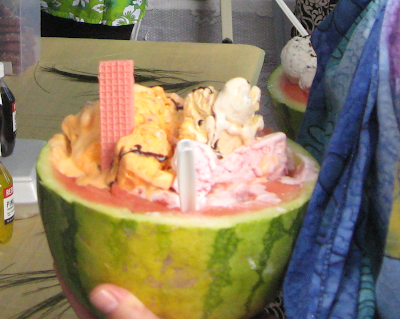 |
| One of the "villages" by the lakeside |
For me, practically everything was a novelty—from the 'ota 'ika (raw fish salad in coconut cream), pork buns and pani popo (buns in coconut milk sauce) which my friends went for—to the curry on cassava, pisua (a tapioca dessert which tasted of butterscotch) and pani keke ("banana pancake", more like deep-fried spherical donuts to me) which I tried—to the curiously-named items that we giggled at but did not manage to sample, like poke (Hawaiian raw fish salad) and 'otai (fruit drink with coconut milk). Sapasui (chop suey mainly made with Chinese vermicelli, a.k.a. bean thread or glass noodles) and watermelon icecream also seemed to be very popular.
 |
| Watermelon icecream |
My first reaction was that it was delicious. With coconut cream and savoury onions, the spinach-like packet was very tasty indeed. As I ate though, I began to feel a prickling sensation in my mouth. By the time I got to halfway through the palusami, it was actually painful. Fortunately, unlike Steingarten, my breathing was not affected; but suffice it to say, I had difficulty convincing anyone else to try palusami from another stall.
 |
| Half-eaten palusami |
I haven't completely worked it out yet, but from what I gather from the Taro Wikispaces page, it's not so much the insoluble oxalates such as calcium oxalate which you should be worried about. These pass through your system, while the soluble oxalates (which also exist in taro leaves) are easily absorbed and can lead to kidney stones. You want to boil your leaves (or apply some other moist heat treatment) and throw away the water to reduce the soluble oxalate levels. You can also eat your taro leaves with a calcium-rich food like milk so that insoluble calcium oxalate salts get formed, thus reducing oxalate absorption.
After reading the sections on Elephant Ear (a close relative of taro, with large leaves) and Taro in the book Poisonous Plants of Paradise: First Aid and Medical Treatment of Injuries from Hawaii's Plants by Susan Scott and Craig Thomas, it occurs to me that I may have eaten a specimen of the plant that simply cannot be made edible by any amount of cooking. Perhaps cooks would do well to heed the advice shared on Elaichi et Cetera: "A tip from Vee of Past, Present and Me: break the stem of an arbi [a.k.a. taro] leaf you intend to use, rub the juice on your inner wrist and count to ten; if it stings, the oxylate concentration is too high. Don’t use them."